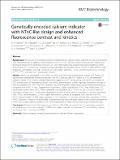| dc.contributor.author | Doronin, D. A | |
| dc.contributor.author | Barykina, N. V | |
| dc.contributor.author | Subach, O. M | |
| dc.contributor.author | Sotskov, V. P | |
| dc.contributor.author | Plusnin, V. V | |
| dc.contributor.author | Ivleva, O. A | |
| dc.contributor.author | Isaakova, E. A | |
| dc.contributor.author | Varizhuk, A. M | |
| dc.contributor.author | Pozmogova, G. E | |
| dc.contributor.author | Malyshev, A. Y | |
| dc.contributor.author | Smirnov, I. V | |
| dc.contributor.author | Anokhin, K. V | |
| dc.contributor.author | Enikolopov, G. N | |
| dc.contributor.author | Subach, F. V | |
| dc.contributor.author | Doronin, D. A. | |
| dc.contributor.author | Barykina, N. V. | |
| dc.contributor.author | Subach, O. M. | |
| dc.contributor.author | Sotskov, V. P. | |
| dc.contributor.author | Plusnin, V. V. | |
| dc.contributor.author | Ivleva, O. A. | |
| dc.contributor.author | Isaakova, E. A. | |
| dc.contributor.author | Varizhuk, A. M. | |
| dc.contributor.author | Pozmogova, G. E. | |
| dc.contributor.author | Malyshev, A. Y. | |
| dc.contributor.author | Smirnov, I. V. | |
| dc.contributor.author | Piatkevich, K. D. | |
| dc.contributor.author | Anokhin, K. V. | |
| dc.contributor.author | Enikolopov, G. N. | |
| dc.contributor.author | Subach, F. V. | |
| dc.contributor.author | Piatkevich, Kiryl | |
| dc.date.accessioned | 2018-03-29T18:21:24Z | |
| dc.date.available | 2018-03-29T18:21:24Z | |
| dc.date.issued | 2018-02 | |
| dc.date.submitted | 2017-08 | |
| dc.identifier.issn | 1472-6750 | |
| dc.identifier.uri | http://hdl.handle.net/1721.1/114454 | |
| dc.description.abstract | Background
The recently developed genetically encoded calcium indicator (GECI), called NTnC, has a novel design with reduced size due to utilization of the troponin C (TnC) as a Ca²⁺-binding moiety inserted into the mNeonGreen fluorescent protein. NTnC binds two times less Ca²⁺ ions while maintaining a higher fluorescence brightness at the basal level of Ca²⁺ in neurons as compared with the calmodulin-based GECIs, such as GCaMPs. In spite of NTnC’s high brightness, pH-stability, and high sensitivity to single action potentials, it has a limited fluorescence contrast (F-Ca²⁺/F⁺Ca²⁺) and slow Ca²⁺ dissociation kinetics.
Results
Herein, we developed a new NTnC-like GECI with enhanced fluorescence contrast and kinetics by replacing the mNeonGreen fluorescent subunit of the NTnC indicator with EYFP. Similar to NTnC, the developed indicator, named iYTnC2, has an inverted fluorescence response to Ca²⁺ (i.e. becoming dimmer with an increase of Ca²⁺ concentration). In the presence of Mg²⁺ ions, iYTnC2 demonstrated a 2.8-fold improved fluorescence contrast in vitro as compared with NTnC. The iYTnC2 indicator has lower brightness and pH-stability, but similar photostability as compared with NTnC in vitro. Stopped-flow fluorimetry studies revealed that iYTnC2 has 5-fold faster Ca²⁺ dissociation kinetics than NTnC. When compared with GCaMP6f GECI, iYTnC2 has up to 5.6-fold faster Ca²⁺ association kinetics and 1.7-fold slower dissociation kinetics. During calcium transients in cultured mammalian cells, iYTnC2 demonstrated a 2.7-fold higher fluorescence contrast as compared with that for the NTnC. iYTnC2 demonstrated a 4-fold larger response to Ca²⁺ transients in neuronal cultures than responses of NTnC. iYTnC2 response in neurons was additionally characterized using whole-cell patch clamp. Finally, we demonstrated that iYTnC2 can visualize neuronal activity in vivo in the hippocampus of freely moving mice using a nVista miniscope.
Conclusions
We demonstrate that expanding the family of NTnC-like calcium indicators is a promising strategy for the development of the next generation of GECIs with smaller molecule size and lower Ca²⁺ ions buffering capacity as compared with commonly used GECIs. | en_US |
| dc.publisher | BioMed Central | en_US |
| dc.relation.isversionof | http://dx.doi.org/10.1186/s12896-018-0417-2 | en_US |
| dc.rights | Creative Commons Attribution | en_US |
| dc.rights.uri | http://creativecommons.org/licenses/by/4.0/ | en_US |
| dc.source | BioMed Central | en_US |
| dc.title | Genetically encoded calcium indicator with NTnC-like design and enhanced fluorescence contrast and kinetics | en_US |
| dc.type | Article | en_US |
| dc.identifier.citation | Doronin, D. A. et al. "Genetically encoded calcium indicator with NTnC-like design and enhanced fluorescence contrast and kinetics." BMC Biotechnology 18 (February 2018): 10 © 2018 The Author(s) | en_US |
| dc.contributor.department | Massachusetts Institute of Technology. Media Laboratory | en_US |
| dc.contributor.mitauthor | Piatkevich, Kiryl | |
| dc.relation.journal | BMC Biotechnology | en_US |
| dc.eprint.version | Final published version | en_US |
| dc.type.uri | http://purl.org/eprint/type/JournalArticle | en_US |
| eprint.status | http://purl.org/eprint/status/PeerReviewed | en_US |
| dc.date.updated | 2018-02-18T04:18:11Z | |
| dc.language.rfc3066 | en | |
| dc.rights.holder | The Author(s). | |
| dspace.orderedauthors | Doronin, D. A.; Barykina, N. V.; Subach, O. M.; Sotskov, V. P.; Plusnin, V. V.; Ivleva, O. A.; Isaakova, E. A.; Varizhuk, A. M.; Pozmogova, G. E.; Malyshev, A. Y.; Smirnov, I. V.; Piatkevich, K. D.; Anokhin, K. V.; Enikolopov, G. N.; Subach, F. V. | en_US |
| dspace.embargo.terms | N | en_US |
| mit.license | PUBLISHER_CC | en_US |
